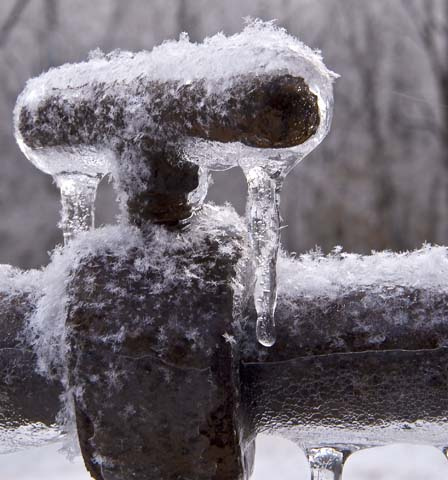Ways to Safeguard Pipes from Freezing: Specialist Tips
Ways to Safeguard Pipes from Freezing: Specialist Tips
Blog Article
We have discovered this article on Prevent Frozen Pipes below on the net and felt it made sense to write about it with you over here.

Winter can ruin your pipes, particularly by freezing pipes. Right here's exactly how to stop it from taking place and what to do if it does.
Intro
As temperatures drop, the risk of frozen pipes increases, possibly leading to costly repairs and water damage. Recognizing just how to stop icy pipes is important for property owners in cold environments.
Avoidance Tips
Protecting susceptible pipes
Cover pipes in insulation sleeves or use warmth tape to safeguard them from freezing temperatures. Concentrate on pipes in unheated or external areas of the home.
Home heating methods
Maintain indoor areas effectively warmed, particularly areas with plumbing. Open closet doors to permit cozy air to distribute around pipes under sinks.
Just how to recognize icy pipes
Look for lowered water flow from faucets, uncommon odors or noises from pipelines, and visible frost on exposed pipelines.
Long-Term Solutions
Structural changes
Take into consideration rerouting pipes far from exterior wall surfaces or unheated areas. Include extra insulation to attics, cellars, and crawl spaces.
Updating insulation
Purchase high-grade insulation for pipes, attics, and walls. Appropriate insulation helps preserve regular temperatures and decreases the risk of frozen pipelines.
Securing Exterior Plumbing
Garden hoses and exterior taps
Disconnect and drain pipes yard hose pipes prior to winter months. Set up frost-proof spigots or cover outside faucets with shielded caps.
Comprehending Icy Pipelines
What causes pipes to ice up?
Pipes ice up when exposed to temperature levels listed below 32 ° F (0 ° C) for prolonged durations. As water inside the pipes ices up, it increases, putting pressure on the pipe wall surfaces and potentially creating them to burst.
Threats and problems
Frozen pipelines can lead to water system disturbances, residential property damages, and expensive repair work. Burst pipelines can flooding homes and trigger considerable architectural damages.
Indicators of Frozen Piping
Identifying icy pipelines early can stop them from breaking.
What to Do If Your Pipelines Freeze
Immediate actions to take
If you think frozen pipes, maintain taps available to eliminate pressure as the ice melts. Use a hairdryer or towels taken in warm water to thaw pipelines slowly.
Conclusion
Stopping frozen pipes requires positive steps and quick actions. By recognizing the causes, indications, and safety nets, property owners can shield their pipes throughout cold weather.
6 Proven Ways to Prevent Frozen Pipes and Protect Your Home
Disconnect and Drain Garden Hoses
Before winter arrives, start by disconnecting your garden hoses and draining any remaining water. Close the shut-off valves that supply outdoor hose bibs and leave the outdoor faucet open to allow any residual water to drain. For extra protection, consider using faucet covers throughout the colder months. It’s also important to drain water from any sprinkler supply lines following the manufacturer’s directions.
Insulate Exposed Pipes
Insulating your pipes is an effective way to prevent freezing. Pipe insulation is readily available at home improvement stores and is relatively inexpensive. Pay close attention to pipes in unheated areas such as the attic, basement, crawl spaces, or garage. Apply foam insulation generously to create a buffer against the cold. You can also wrap your pipes in heat tape or thermostat-controlled heat cables for added warmth.
Seal Air Leaks
Inspect your home for any cracks or openings that could let in cold air. Seal any holes around the piping in interior or exterior walls, as well as the sill plates where your home rests on its foundation. Additionally, make sure to keep your garage door closed unless you’re entering or exiting. Leaving it open creates a significant air leak that can lead to frozen pipes.
Allow Warm Air Circulation
During cold snaps, it’s essential to allow warm air to circulate evenly throughout your home. Leave interior doors ajar to promote better airflow. Open kitchen and bathroom cabinets to help distribute heat consistently around the rooms. If you have small children or pets, be sure to remove any household chemicals or potentially harmful cleaners from open cabinets for safety.
Let Faucets Drip
A small trickle of water can make a big difference in preventing ice formation inside your pipes. When temperatures drop significantly, start a drip of water from all faucets served by exposed pipes. This continuous flow helps prevent the water from freezing. Additionally, running a few faucets slightly can relieve pressure inside the pipes, reducing the chances of a rupture if the water inside does freeze.
https://choateshvac.com/6-proven-ways-to-prevent-frozen-pipes-and-protect-your-home/

Hopefully you enjoyed reading our article about Helpful Tips to Prevent Frozen Pipes this Winter. Thank you for taking the time to read through our post. Are you aware of anybody else who is sincerely interested in the niche? Why not share it. Thanks so much for your time spent reading it.
Call Today Report this page